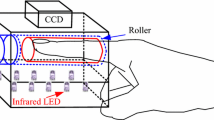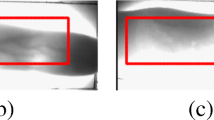Abstract
Automatic finger vein recognition systems have attracted more attentions in recent years. In order to implement a high performance system, an important step is to localize the region of interest accurately. A problem in previous ROI localization methods is that some useful finger vein information is lost in the final cropped ROI region. In order to resolve this problem, a novel ROI extraction method for finger vein images is proposed in this paper. Finger edges are detected and adjusted to the horizontal direction, after that a modified sliding window is used in order to detect the distal inter-joint line of the finger. On the basis of the edges and the distal inter-phalangeal joint line of the finger, different from previous methods, an outer rectangle is used to crop the finger area to avoid the useful information loss. Based on our experimental dataset with 3132 finger vein images, the mean information loss rate for previous methods is 15.1% and there is no loss of information for our method. In order to evaluate the accuracy of our ROI extraction method, the similarity rate of intra-class is calculated, which is defined by the ratio of overlap area and the whole ROI area. And a mean similarity rate 96.3% is obtained in our experiments. Theoretical analysis and experimental results show that the proposed method is effective and accurate, and it is potentially beneficial for improving the performance of finger vein recognition system.










Similar content being viewed by others
References
Asaari M, Suandi S, Rosdi B (2014) Fusion of band limited phase only correlation and width centroid contour distance for finger based biometrics. Expert Syst Appl 41(7):3367–3382
Kauba C, Uhl A (2015) Sensor ageing impact on finger-vein recognition. 2015 International Conference on Biometrics Compendium. Phuket, Thailand, 19–22 May, 113–120
Khellat S, Abrishambaf R, Monteiro JL et al (2016) Multimodal fusion of the finger vein, fingerprint and the finger-knuckle-print using kernel fisher analysis. Appl Soft Comput 42:439–447
Kumar A, Yingbo Z (2012) Human identification using finger images. IEEE Trans Image Process 2012(21):2228–2244
Liu Z, Song S (2012) An embedded real-time finger-vein recognition system for mobile devices. IEEE Trans Consum Electron 58(2):522–527
Liu Y, Zhou Y, Qiu S, et al. (2015) Real-time locating method for palmvein image acquisition. Image and Graphics. LNCS 9219, 94–110
Lu Y, Xie SJ, Yoon S, et al. (2013a) An Available Database for the Research of Finger Vein Recognition. 2013 6th International Congress on Image and Signal Processing. Hangzhou, China, 16–18 December, 410–415
Lu Y, Xie SJ, Yoon S, etc. (2013b) Robust Finger Vein ROI Localization Based on Flexible Segmentation. Sensors 2013(11):14339–14366
Lu Y, Gongping Y, Yilong Y, etc. (2013c) Sliding Window-Based Region of Interest Extraction for Finger Vein Images. Sensors 2013(3):3799–3815
Matsuda Y, Miura N, Nagasaka A, etc. (2016) Finger-vein authentication based on deformation-tolerant feature-point matching. Mach Vis Appl 27(2):237–250
Meng X, Yang G, Yin Y, Xiao R (2012) Finger vein recognition based on local directional code. Sensors 2012(12):14937–14952
Raghvavedra R, Busch C (2015) Exploring dorsal finger vein pattern for robust person recognition. Int Conf biometrics:341–348
Rosdi BA, Shing CW, Suandi SA (2011) Finger vein recognition using local line binary pattern. Sensors 2011(11):11357–11371
Sharma S, Bhushan S, Kaur J (2014) Improved human identification using finger vein images: a review. Int J Adv Res Comput Sci Technol 2(1):32–34
Shirong Q, Yaqin L, Yujia Z, etc. (2016) Finger-vein recogniton based on dual-sliding window localization and pseudo-elliptical transformer 64, 618–632.
Sierro A, Ferrez P, Roduit R. (2015) Contact-less palm/finger vein biometrics. In International conference of the biometrics special interest group. 1–12.
Van HT, Thai TT, He TH (2015) Robust Finger Vein Identification Base on Discriminant Orientation Feature. 2015 Seventh International Conference on Knowledge and Systems Engineering, Ho Chi Minh City, 8–10 October, 348–353
Vlachos M, Dermatas E (2015) Finger vein segmentation from infrared images based on a modified separable Mumford shah model and local entropy thresholding. Comput Math Methods Med 1-20
Ran Xian, Liao Ni, Wenxin Li (2015) The ICB-2015 Competition on Finger Vein Recognition. Proceedings of 2015 International Conference on Biometrics Compendium, Phuket, Thailand, 19–22 May, 85–89
Xie S, Yang JC, Yoon S, et al. (2012) Guided Gabor Filter for Finger Vein Pattern Extraction. 2012 Eighth International Conference on Signal Image Technology and Internet Based Systems, Sorrento, Naples, Italy, 25–29 November, 118–123
Xie S, Lu Y, Yoon S, etc. Intensity variation normalization for finger vein recognition using guided filter based singe scale retinex. Sensors 2015, 15(7), 17089–17105.
Yang JF, Shi YH (2012) Finger-vein ROI localization and vein ridge enhancement. Pattern Recogn Lett 2012(33):1569–1579
Yang G, Xi X, Yin Y (2012a) Finger vein recognition based on (2D)2 PCA and metric learning. J Biomed Biotechnol 3:1–9
Yang Y, Yang G, Wang S (2012b) Finger-vein recognition based on multi-instance. International Journal of Digital Content Technology and its Applications 6(11):86–94
Yang L, Yang G, Zhou L, Yin Y (2015) Superpixel based finger vein ROI extraction with sensor interoperability. 2015 International Conference on IEEE Biometrics Compendium (ICB). Phuket, 19–22 May, 444–451
Zhou Y, Liu Y, Feng Q, etc. Palm-vein classification based on principal orientation features. PLoS One 2013, 9(11), e116446-e116446.
Acknowledgements
This work is supported by National Natural Science Foundation of China under Grant No. 61373009 and 61100118, the Science and Technology Support Project of Sichuan province under Grant No. 2013GZX0166, 2015GZ0089 and the Fundamental Research Funds for the Central Universities under Grant No. 2682014CX055.
Author information
Authors and Affiliations
Corresponding author
Rights and permissions
About this article
Cite this article
Wang, M., Tang, D. Region of interest extraction for finger vein images with less information losses. Multimed Tools Appl 76, 14937–14949 (2017). https://doi.org/10.1007/s11042-016-4285-2
Received:
Revised:
Accepted:
Published:
Issue Date:
DOI: https://doi.org/10.1007/s11042-016-4285-2




